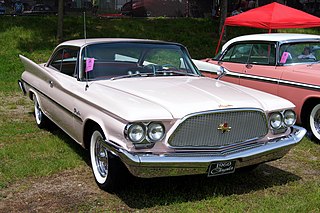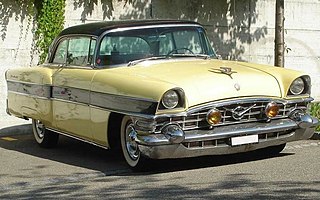
Packard was an American luxury automobile company located in Detroit, Michigan. The first Packard automobiles were produced in 1899, and the last Packards were built in South Bend, Indiana, in 1958.

The Chevrolet Bel Air is a full-size car produced by Chevrolet for the 1950–1981 model years. Initially, only the two-door hardtops in the Chevrolet model range were designated with the Bel Air name from 1950 to 1952. With the 1953 model year, the Bel Air name was changed from a designation for a unique body shape to a premium level of trim applied across a number of body styles. The Bel Air continued with various other trim level designations, and it had gone from a mid-level trim car to a budget fleet sedan when U.S. production ceased in 1975. Production continued in Canada, for its home market only, through the 1981 model year.

The Buick Electra is a full-size luxury car manufactured and marketed by Buick from 1959 to 1990, over six generations. Introduced as the replacement for the Roadmaster lines, the Electra served as the flagship Buick sedan line through its entire production and was offered as a six-passenger four-door sedan with two-door sedan, two-door convertible, and five-door station wagon variants.

The Pontiac Catalina is a full-size, junior series automobile produced by Pontiac from 1950 to 1981. Initially, the name was a trim line on hardtop body styles, first appearing in the 1950 Chieftain Eight and DeLuxe Eight lines. In 1959, it became a separate model as the "entry-level" full-size Pontiac.

The Chrysler New Yorker is an automobile model produced by Chrysler from 1940 until 1996, serving for several decades as either the brand's flagship model or as a junior sedan to the Chrysler Imperial, the latter during the years in which the Imperial name was used within the Chrysler lineup rather than as a standalone brand.

The Studebaker Golden Hawk is a two-door pillarless hardtop personal luxury car produced by the Studebaker Corporation of South Bend, Indiana, between 1956 and 1958.
The Studebaker-Packard Hawk series were cars produced by the merged Studebaker-Packard corporation between 1956 and 1964. All but the 1958 Packard Hawk were badged Studebaker. Described by the company as "family sports cars", they were all two-door, four-seat coupes and hardtops. They were an evolution of the long wheelbase (120") 1953 C/K models designed by Robert Bourke, lead designer with the Raymond Loewy Agency. The 1962 redesign as the GT Hawk was by another famed stylist, Brooks Stevens.

The Ambassador is an automobile manufactured and marketed by American Motors Corporation (AMC) from 1957 through 1974 over eight generations, available in two- and four-door sedan, two-door hardtop, four-door station wagon as well as two-door convertible body styles. It was classified as a full-size car from 1957 through 1961, mid-size from 1962 until 1966, and again full-size from 1967 through 1974 model years.

The Buick Roadmaster is an automobile that was built by Buick from 1936 until 1942, from 1946 until 1958, and then again from 1991 until 1996. Roadmasters produced between 1936 and 1958 were built on Buick's longest non-limousine wheelbase and shared their basic structure with the entry-level Cadillac Series 65, the Buick Limited, and after 1940, the Oldsmobile 98. Between 1946 and 1957 the Roadmaster served as Buick's flagship.

The Buick LeSabre is a full-size car made by the division Buick of General Motors from 1959 until 2005. Prior to 1959, this position had been retained by the full-size Buick Special model (1936–58). The "LeSabre", which is French for "the sabre", was Buick's mid-level full-size sedan above the Special but below the Electra during the 1960s then remained in its market position when the Electra was replaced with the Park Avenue. The LeSabre was available as a 2-door convertible, sedan or hardtop, a 4-door sedan or hardtop and station wagon throughout its production.

The Studebaker Lark is a compact car that was produced by Studebaker from 1959 to 1966.

The Chrysler Windsor is a full-size car which was built by Chrysler from 1939 through to the 1960s. The final Chrysler Windsor sold in the United States was produced in 1961, but production in Canada continued until 1966. The Canadian 1961 to 1966 Windsor model was for all intents and purposes the equivalent of the Chrysler Newport in the United States.

The Packard Clipper is an automobile that was built by the Packard Motor Car Company for model years 1941–1942, 1946–1947 and 1953–1957. For 1956 only, Clipper was classified as a stand-alone marque. The Clipper was introduced in April 1941, as a mid-model year entry. It was available only as a four-door sedan. The Clipper name was re-introduced in 1953, for the automaker's lowest-priced lineup. By 1955, the Clipper models were seen as diluting Packard's marketing as a luxury automobile marque. It was named for a type of sailing ship, called a clipper.

The Cadillac Series 70 is a full-size V8-powered series of cars that were produced by Cadillac from the 1930s to the 1980s. It replaced the 1935 355E as the company's mainstream car just as the much less expensive Series 60 was introduced. The Series 72 and 67 were similar to the Series 75 but the 72 and 67 were produced on a slightly shorter and longer wheelbase respectively. The Series 72 was only produced in 1940 and the Series 67 was only produced in 1941 and 1942. For much of the postwar era, it was the top-of-the-line Cadillac, and was Cadillac's factory-built limousine offering.

The Cadillac Series 40-62 is a series of cars which was produced by Cadillac from 1940 through 1964. Originally designed to complement the entry level Series 61, it became the Cadillac Series 6200 in 1959, and remained that until it was renamed to Cadillac Calais for the 1965 model year. The Series 62 was also marketed as the Sixty-Two and the Series Sixty-Two. The Series 62 was used to introduce the Cadillac Coupe de Ville and the Cadillac Eldorado which started out as special appearance packages that were later placed into production.

The Ford Fairlane is an automobile model that was sold between the 1955 and 1970 model years by Ford in North America. Taking its name from the Dearborn, Michigan estate of Henry Ford, the Fairlane nameplate was used for seven different generations of vehicles. Through its production, the model line would be marketed in a wide variety of body styles, including two-door and four-door sedans, two-door and four-door hardtops, station wagons, and both traditional and retractable-hardtop convertibles.

The Dodge Polara is an automobile introduced in the United States for the 1960 model year as Dodge's top-of-the-line full-size car. After the introduction of the Dodge Custom 880 in 1962, the Polara nameplate designated a step below the full-sized best-trimmed Dodge model; the Polara that year had been downsized to what was in effect intermediate, or mid-size status. In its various forms, the Polara name was used by Dodge until 1973, when its position in Dodge's line-up was replaced by the Dodge Monaco.

The Packard Executive was an automobile produced by the Packard-Clipper Division of the Studebaker-Packard Corporation in 1956.

The Packard Patrician is an automobile which was built by the Packard Motor Car Company of Detroit, Michigan, from model years 1951 through 1956. During its six years in production, the Patrician was built in Packard's Detroit facilities on East Grand Boulevard. The word "patrician" is Latin for a ruling class in Ancient Rome. It was the last "senior level" Packard until production ended in 1958.

The Dodge lineup was refreshed for the 1958 model year, continuing the three-line scheme of the 1955 Dodges with the entry-level Coronet, Royal, and ornate Custom Royal. The Regal Lancer was added as a new top-of-the-line model in spring.





















